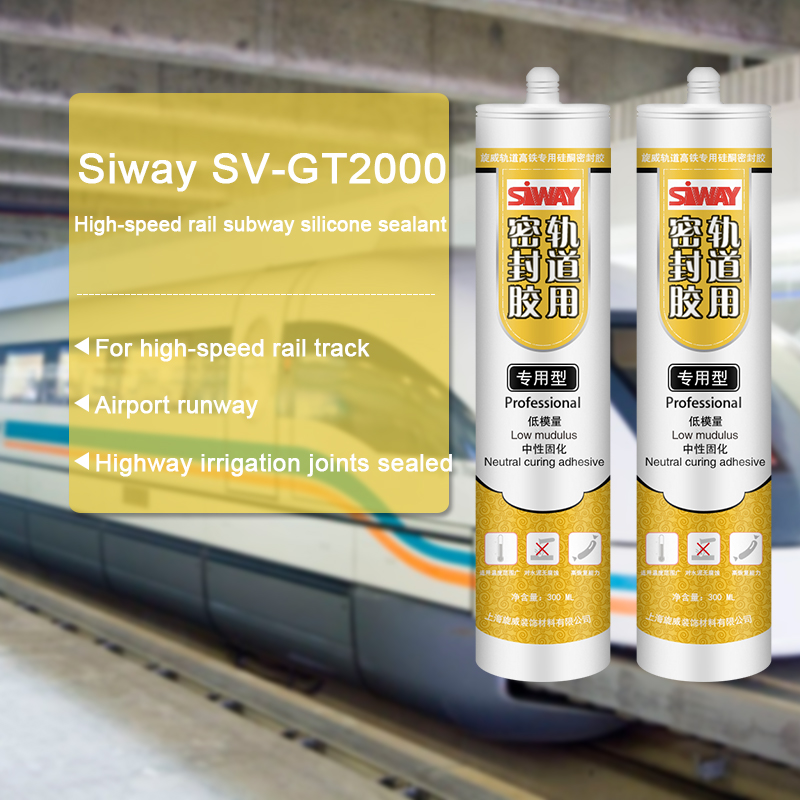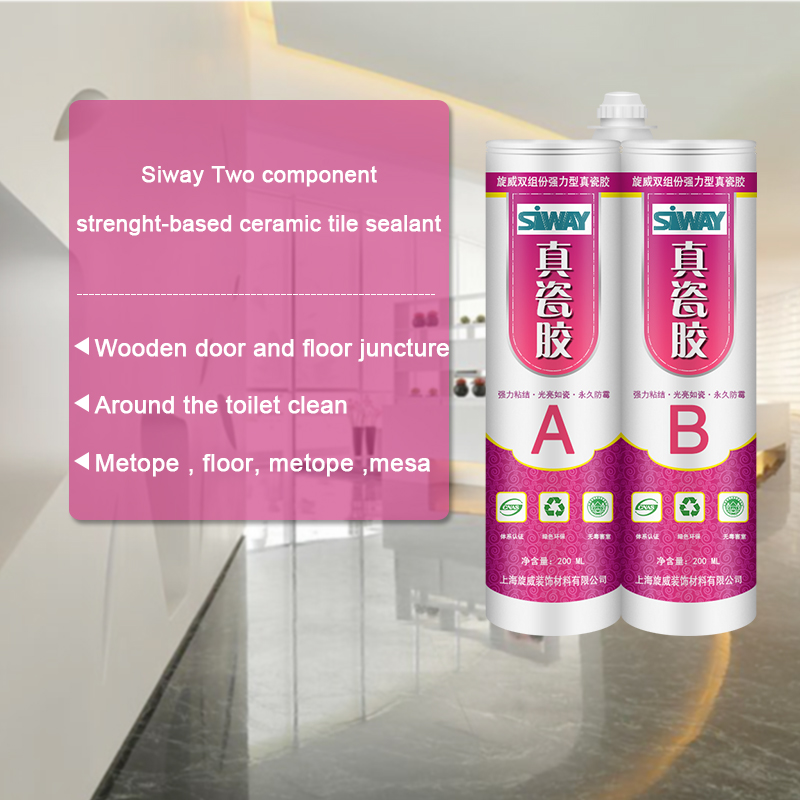Wholesale Dealers of SV-GT2000 High-speed rail subway silicone sealant Export to Salt Lake City
Short Description:
Description SV-GT2000 High-speed rail subway silicone sealant is a one-component, low modulus, neutral curing adhesive. For most of the stone, ceramic and cement components, can produce excellent adhesion Key Features (1) easy to use: can be used at any time out; (2) excellent thixotropy and extrusion, at any temperature (-40 ℃ to 100 ℃) can be extruded; (3) good adhesion, the stone, ceramics and cement components and other building materials with excellent adhesion properties; no poll...
Our company insists all along the quality policy of "product quality is base of enterprise survival; customer satisfaction is the staring point and ending of an enterprise; persistent improvement is eternal pursuit of staff" and the consistent purpose of "reputation first, customer first" for Wholesale Dealers of SV-GT2000 High-speed rail subway silicone sealant Export to Salt Lake City, we are seeking for extensive cooperation with honest customers, achieving a new cause of glory with customers and strategic partners.
Description
SV-GT2000 High-speed rail subway silicone sealant is a one-component, low modulus, neutral curing adhesive. For most of the stone, ceramic and cement components, can produce excellent adhesion
Key Features
(1) easy to use: can be used at any time out;
(2) excellent thixotropy and extrusion, at any temperature (-40 ℃ to 100 ℃) can be extruded;
(3) good adhesion, the stone, ceramics and cement components and other building materials with excellent adhesion properties; no pollution of the porous material;
(4) excellent weather resistance, aging performance, excellent tensile and compression resilience, can carry ± 30% displacement capacity;
(5) neutral curing, stone, cement and other building materials without corrosive, to overcome the shortcomings of acid corrosion material.
(6) base modulus: passive deformation occurs when the role of moderate stress on the concrete substrate to ensure that the concrete surface is not destroyed;
(7) high elasticity high recovery capacity: can be repeated from the seams with the movement, fast response fast response, permanent deformation of small.
Basic Application
1.For high-speed rail track, airport runway, highway irrigation joints sealed, can withstand large displacement;
2.Can also be used for other concrete pavement sealing, subway engineering, tunnels, bridges and other projects sealed.
Technical data sheet
|
Test project |
Unit | value | ||
| surface drying time(25℃,50%R.H.) | min | ≤60 | ||
| Sagging(70℃) | vertical | mm | ≤3 | |
| Horizontal | mm | 0 | ||
| Mass loss rate | / | ≤5% | ||
| Elastic recovery rate | / | ≥80% | ||
| 100% tensile strength | 23℃ | MPa | ≤0.3 | |
| -20℃ | MPa | ≤0.3 | ||
| tensile strength | 23℃ | MPa | ≥1.0 | |
| -20℃ | MPa | ≤2.0 | ||
| 168 h after thermal aging (80 ℃) | MPa | ≥0.8 | ||
| 168 h after alkali treatment | MPa | ≥0.8 | ||
| Breaking elongation | 23℃ | / | ≥800% | |
| -20℃ | / | ≥600% | ||
| 168 h after thermal aging (80 ℃) | / | ≥600% | ||
| 168 h after alkali treatment | / | ≥600% | ||
| Bond strength | 23℃ | / | No damaging | |
| -20℃ | / | No damaging | ||
| 168 h after thermal aging (80 ℃) | / | No damaging | ||
| 96 h after immersion | / | No damaging | ||
Color
Black, White, Gray
Package
300ml in cartridge * 24 per box, 590ml in sausage *20 per box
Shelf life
12 months
Note
If you want the TDS or MSDS or other details, please contact with our sales person.
Available at AdultXFling.com
Behold The Future…Hydrogel superglue is 90 percent water, New “water adhesive” is tougher than natural adhesives employed by mussels and barnacles.
Nature has developed innovative ways to solve a sticky challenge: Mussels and barnacles stubbornly glue themselves to cliff faces, ship hulls, and even the skin of whales. Likewise, tendons and cartilage stick to bone with incredible robustness, giving animals flexibility and agility.
The natural adhesive in all these cases is hydrogel — a sticky mix of water and gummy material that creates a tough and durable bond.
Now engineers at MIT have developed a method to make synthetic, sticky hydrogel that is more than 90 percent water. The hydrogel, which is a transparent, rubber-like material, can adhere to surfaces such as glass, silicon, ceramics, aluminum, and titanium with a toughness comparable to the bond between tendon and cartilage on bone.
In experiments to demonstrate its robustness, the researchers applied a small square of their hydrogel between two plates of glass, from which they then suspended a 55-pound weight. They also glued the hydrogel to a silicon wafer, which they then smashed with a hammer. While the silicon shattered, its pieces remained stuck in place.
Such durability makes the hydrogel an ideal candidate for protective coatings on underwater surfaces such as boats and submarines. As the hydrogel is biocompatible, it may also be suitable for a range of health-related applications, such as biomedical coatings for catheters and sensors implanted in the body.
“You can imagine new applications with this very robust, adhesive, yet soft material,” says Xuanhe Zhao, the Robert N. Noyce Career Development Associate Professor in MIT’s Department of Mechanical Engineering. For example, Zhao’s group is currently exploring uses for the hydrogel in soft robotics, where the material may serve as synthetic tendon and cartilage, or in flexible joints.
“It’s a pretty tough and adhesive gel that’s mostly water,” Hyunwoo Yuk, a graduate student in mechanical engineering and the lead author of a paper on the work, says. “Basically, it’s tough, bonding water.”
Zhao and his students publish their results today in the journal Nature Materials.
A stretchy anchor…
A tough, flexible hydrogel that bonds strongly requires two characteristics, Zhao found: energy dissipation and chemical anchorage. A hydrogel that dissipates energy is essentially able to stretch significantly without retaining all the energy used to stretch it. A chemically anchored hydrogel adheres to a surface by covalently bonding its polymer network to that surface.
“Chemical anchorage plus bulk dissipation leads to tough bonding,” Zhao says. “Tendons and cartilage harness these, so we’re really learning this principle from nature.”
In developing the hydrogel, Yuk mixed a solution of water with a dissipative ingredient to create a stretchy, rubbery material. He then placed the hydrogel atop various surfaces, such as aluminum, ceramic, glass, and titanium, each modified with functional silanes — molecules that created chemical links between each surface and its hydrogel.
The researchers then tested the hydrogel’s bond using a standard peeling test, in which they measured the force required to peel the hydrogel from a surface. On average, they found the hydrogel’s bond was as tough as 1,000 joules per square meter — about the same level as tendon and cartilage on bone.
Zhao group compared these results with existing hydrogels, as well as elastomers, tissue adhesives, and nanoparticle gels, and found that the new hydrogel adhesive has both higher water content and a much stronger bonding ability.
“We basically broke a world record in bonding toughness of hydrogels, and it was inspired by nature,” Yuk says.
https://news.mit.edu/2015/hydrogel-superglue-water-adhesive-1109
———————————————————————————————————–
Newly engineered water superglue (MIT Video)






